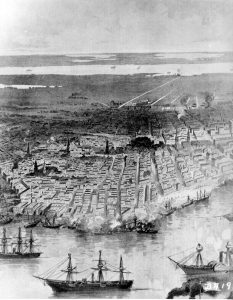In The Silence: Occupied Cities of the South

Beginning of a series
When the American Civil War began, no one on either side thought the conflict would last more than a few months – let alone four years.
Those in the North didn’t view their southern counterparts as “Rebels,” but as victims deceived by extremist politicians. They had no idea just how deep the southern cause – be it slavery or the need to protect their way of life – ran in the hearts of the Confederate people.
Indeed, the North’s initial policy towards citizens of occupied territory was conciliatory: convince the “hoodwinked” southerners they had been misled, show them the truth, and bring them back to the fold. During the first months of the war, most Union military officers made it a point to protect southern civilians and their property – including slaves.
It wasn’t long before the North started to see the truth: that the southern states would never abandon their way of life without a fight. And that they would take advantage of any opportunity to display their southern pride and hatred of the North.
Union troops would go on to occupy an estimated 100 towns and cities in the South – no small feat for a military unaccustomed to occupation, let alone occupation of a nation they considered home.
As the war continued, southerners were constantly faced with the threat of enemy occupation as battles were won or lost. In this case, the enemy was the US Army and a president sworn to put the word United back into the United States.
From 1861 to 1865, Union troops would occupy large swaths of Virginia, Tennessee, and states bordering the Mississippi River. Major occupied cities included Nashville, New Orleans, Vicksburg, and Atlanta.
Over the next few weeks, my posts will be taking an in-depth look at some of these cities and the problems faced by both occupiers and occupied. Stay tuned!
I am glad to see this series bringing to readers a comprehensive look at the deeply fraught for both occupiers and occupied the experience of captive cities in the Southern states that became a significant part of Southern civilian experience as the Civil War progressed. I look forward to the additional posts.
British scholar Dr. Susan-Mary Grant’s book “North Over South” provides a rare objective look at the North’s determination to create the entire country in its image. The pursuit of happiness was to be defined by the North or not at all. And contrary to the popular narrative, the image the North had in mind was neither egalitarian or truly free.
I recommend “Armies of Deliverance”, Elizabeth Varon, UVa, PhD. The benevolent tone of “amazed Northerner” belies the real political and financial motives, and the infinitely more complex reality than “confused Northerners who had no idea….”